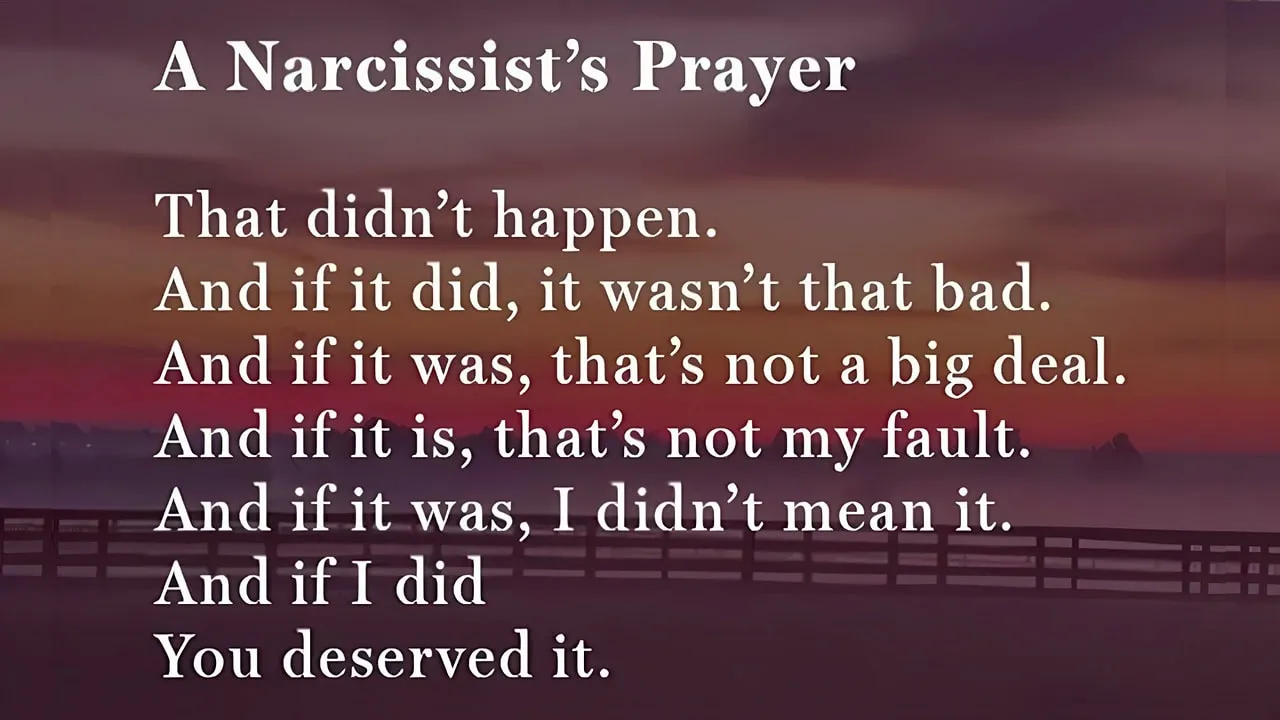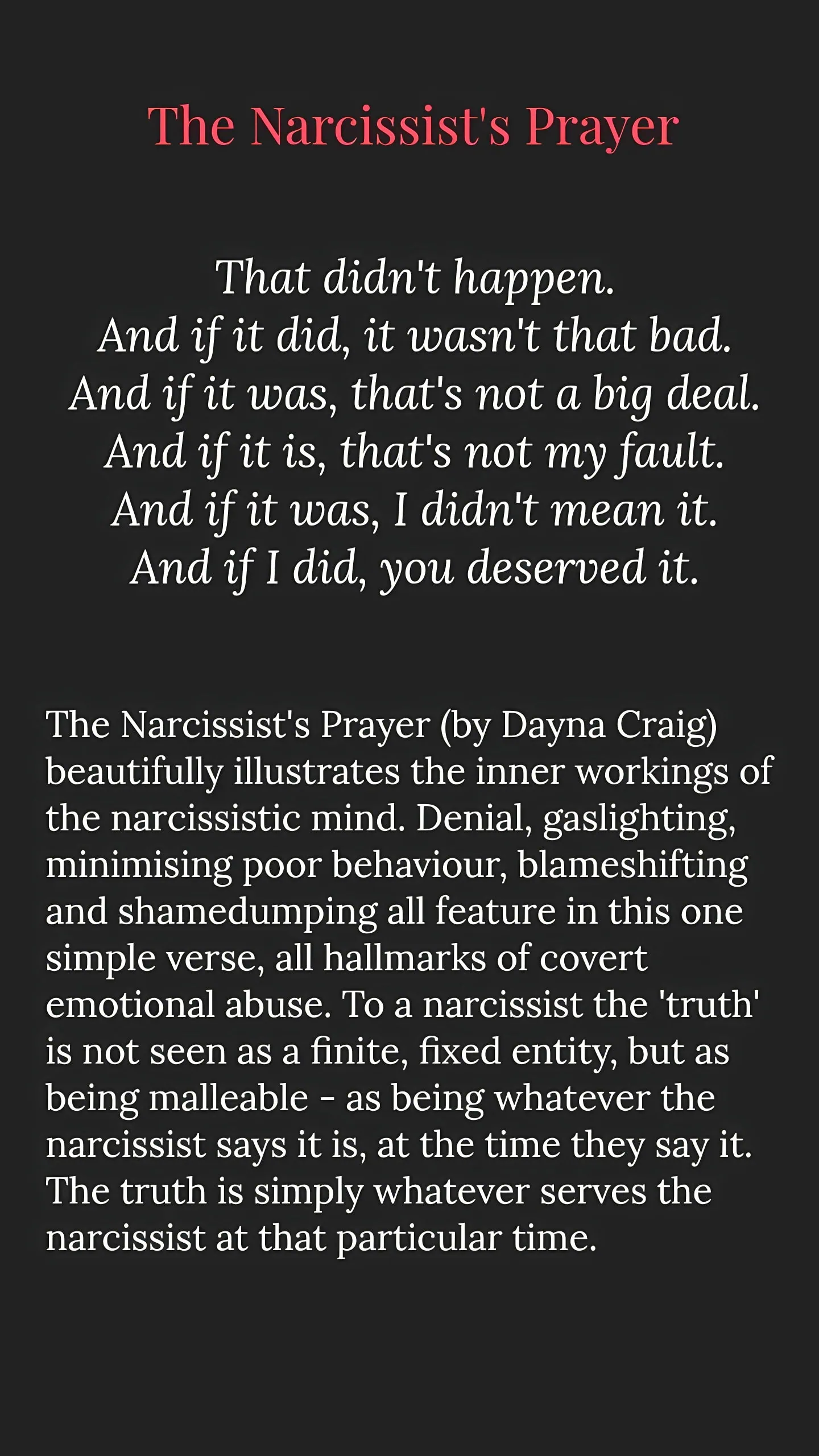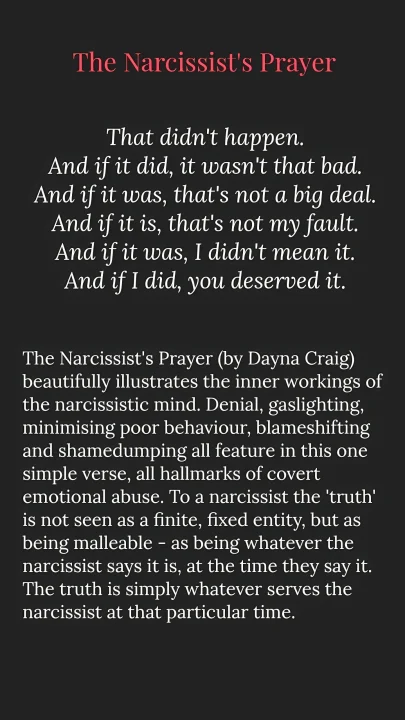Today's Sunday • 7 mins read
- A narcissist’s ego is fragile, despite their outward arrogance and confidence.
- To keep their ego large and perfect, they need constant attention and validation.
- And to make people praise and respect them, they must act like they are excellent at what they do.
But when people call them out for their faults, they perceive it as an attack on their ego. So they quickly react with denial, blame-shifting, or anger to defend their self-worth.
And this forms the background of The Narcissist’s Prayer.
What I mean by a narcissist’s ego is their larger-than-life self-image.
But first, why is it called a “prayer”?
Why is “The Narcissist’s Prayer” called a prayer?
A prayer is a petition or appeal to a higher power or God. Yet in The Narcissist’s Prayer, they are not petitioning to any God over them.
They are, in fact, praying to the higher power that is them. After all, they are a narcissist — they can worship only themselves.
So, it is a self-serving prayer, much like how one would recite a prayer, to manifest their desire.
And their constant desire is to manipulate and dominate others with tools like blame-shifting and victim-shaming.
The Narcissist’s Prayer: Psychological Tools It Uses
The Narcissist’s Prayer offers a shockingly candid glimpse into the inner workings of the narcissistic mind.

That didn’t happen.
— Dayna Craig
And if it did, it wasn’t that bad.
And if it was, that’s not a big deal.
And if it is, that’s not my fault.
And if it was, I didn’t mean it.
And if I did, you deserved it.
As a happiness researcher and well-being therapist, I’ve found these lines capture the hallmark signs of a narcissist and Narcissistic Personality Disorder (NPD).
Let’s break down what it reveals.
1. Denial and Gaslighting
The prayer begins with denial: “That didn’t happen.”
They flatly deny the event or action ever occurred. Even when they are shown proof of their hurtful acts, they can refuse to admit it.
The denial of wrongdoing helps preserve the narcissist’s self-image. Their glorious self-image feels an existential threat when admitting a fault.
They follow this up with gaslighting — their foxy attempts to reshape the victim’s reality to fit their narrative.
Gaslighted victims start doubting what they saw, heard, or have memories of. The narcissist gradually convinces them to trust his version of what happened.
2. Minimizing
If the narcissist can’t deny their hand outright, they try to minimize it.
“And if it did, it wasn’t that bad.
And if it was, that’s not a big deal.”
This is minimizing—downplaying the enormity of their actions.
They are trying to gaslight. With those words, the narcissist means to say,
“That’s such a small issue. Nobody would even bother. You’re unnecessarily blowing it up! Either that, or you have become too touchy — I wonder who’s doing that to you?”
They point the finger back at the victim to accuse them of overreacting or being oversensitive.
Minimization has 3 objectives:
- Downplays the seriousness of the issue
- Invalidates how the victim feels or reacts to it
- Keeps the narcissist on his platform of superiority
3. Blame-shifting
When that fails, they blame the shift: “And if it is, that’s not my fault.”
Narcissists have difficulty taking responsibility for how their behavior impacts others. So, they resort to their default: Lay the blame on someone else or on a circumstance.
Some other ways they say it:
- “It’s not my fault they didn’t give me the promotion; my coworker sabotaged me.”
- “It’s not my fault that I stole from the company; the economy is bad.”
- “It’s not my fault that yelled at you — you made me so angry!”
- “It’s not my fault that you misunderstood what I said.”
- “It’s not my fault if you’re too sensitive.”

4. False Apology And Fake Empathy
“And if it was, I didn’t mean it.”
“And if it was, I didn’t mean it” is their classic false apology.
In which, they apologize to calm you down or avoid the consequences. Or to gain something they want, like to be liked or to control the situation.
They don’t truly mean any word of it.
When a narcissist says, “I didn’t mean it,” they are trying to:
- Shirk Responsibility: By saying they didn’t mean it, they skirt accountability. They imply that their behavior was unintentional or accidental, and they cannot take responsibility for it.
- Fake Empathy: The narcissist is feigning empathy — that they know you’re feeling hurt. But this is just a sly way to mellow the victim and get their sympathy. They are not truly sorry, but saying that helps avoid genuine remorse. And they can keep feeling better inside.
- Maintain Control: If you notice, this is a shifting of focus from their actions to their intentions. They are controlling the narrative. They are diverting attention from their wrongdoing to their supposed innocence, which helps them maintain their self-image as a victim or a misunderstood hero.
- Gaslighting: This also gaslights the victim to doubt their own perceptions. Saying they didn’t mean it, the narcissist implies that the victim is misinterpreting the situation (as the narcissist’s fault). Thus, eroding the victims’ trust in themselves.
- Avoid Emotional Confrontation: Apologizing without taking responsibility lets them avoid an emotional confrontation. They are sidestepping discussing the emotional discomfort of their actions. This is pushing the issue under the carpet, for good.
5. Victim-Shaming
This line — “And if I did, you deserved it” — shows false justification and victim shaming.
- False justification: It is a made-up defense, often tonally grim and morally wrong, that is meant to shut down the victim.
- Victim shaming: It is a form of psychological manipulation where the victim is made to feel guilty and responsible for the abuser’s actions.
The narcissist is trying to justify his actions by implying that the victim was somehow responsible or deserving of the treatment.
This is their final tactic to close the argument.
They tell how the narcissist’s manipulation escalates into a shameless attack on the victim.
What they’re trying to do is convince the other person that their feelings are irrelevant in the current discussion.
This strategy confuses and puts the victim on the defensive. They are no longer focusing on their abusive conduct.
And this helps the narcissist dodge accountability.
6. The Malleability of Truth
One last takeaway from The Narcissist’s Prayer is that for narcissists, the “truth” is not fixed. The narcissist can change the narrative to suit their needs.
For them, facts are whatever serves to move forward their agenda at the moment. They can arrogantly dismiss facts and other people’s feelings.
I have heard a narcissist say this on television,
“Facts are not facts.”
To victims, and everyone else, it is callousness and threat to not oppose them again.

Overall, the prayer is their DARVO — Deny, Attack, Reverse Victim Offender — tactic.
- First, they deny the wrongdoing, claiming it never happened or wasn’t their fault.
- Next, they attack the accuser, aiming to discredit and intimidate them.
- Finally, they reverse the roles of victim and offender. So they portray themselves as the real victim and make the actual victim seem like the aggressor.
Final Words
If you relate to “The Narcissist’s Prayer” from your own experiences, know that you aren’t alone.
Assure yourself that you are not to take the blame just because your narcissist thinks and says so.
Reach out to a counselor who understands narcissistic abuse for support in healing and setting healthy boundaries.
Once your thought process has cleared up, ask yourself, do you need this toxic person in your life?
